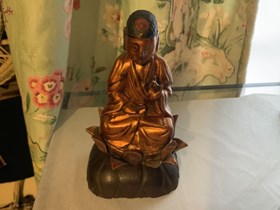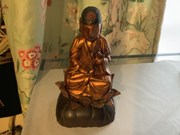Narrow Results By
- Date
- 1930 – 1940
- Material
- wood
- Catalogue Number
- 107.01.0086
- Description
- A seated buddha with his feet in a lotus position at the centre of a lotus blossom. His right hand rests palm up in his lap and the left is raised in a blessing (or teaching position). The carved figurine is wood with simple features, large ears, and draped robes. The figurine is painted a saffro…
1 image
- Title
- Figurine
- Date
- 1930 – 1940
- Material
- wood
- Dimensions
- 12.7 x 6.0 x 7.0 cm
- Description
- A seated buddha with his feet in a lotus position at the centre of a lotus blossom. His right hand rests palm up in his lap and the left is raised in a blessing (or teaching position). The carved figurine is wood with simple features, large ears, and draped robes. The figurine is painted a saffron gold colour with red and black features and black hair with carved and red painted dot at front centre of hair. The figurine is loosely attached to a simply carved brown wood base of leaves curling downward with dowel through base of the buddha. There are Chinese letters on the base of the stand and “1.50” along with a paper sticker that reads “China:.
- Subject
- households
- souvenirs
- religious
- Buddah
- Credit
- Gift of Pearl Evelyn Moore, Banff, 1979
- Catalogue Number
- 107.01.0086
Images
This material is presented as originally created; it may contain outdated cultural descriptions and
potentially offensive content.
Read more.
Miniature; Japanese House
https://archives.whyte.org/en/permalink/artifact105.02.0120
- Date
- 1870 – 1890
- Material
- wood; paper
- Catalogue Number
- 105.02.0120
- Description
- Traditional Japanese house model. 2 storey wood construction which disassembles into 10 pieces. The rectangular base is raised slightly above ground level by a narrower under base. 12 wood and paper, and 2 wooden lattice work sliding panels open up to verandas on each level, front and back. 1 hinge…
1 image
- Title
- Miniature; Japanese House
- Date
- 1870 – 1890
- Material
- wood; paper
- Dimensions
- 21.8 x 19.7 x 27.3 cm
- Description
- Traditional Japanese house model. 2 storey wood construction which disassembles into 10 pieces. The rectangular base is raised slightly above ground level by a narrower under base. 12 wood and paper, and 2 wooden lattice work sliding panels open up to verandas on each level, front and back. 1 hinged door of wood and paper in front, roof is peaked with exterior ride pole and no decoration. The 2 sides of the roof are held together by a piece of tape which acts like a hinge. Inside a raised platform spans the width and 3/4 the length of the main floor. The second floor is made from a single thin slab of wood. "Made in Japan" is stamped onto tape on roof, both bases, the second floor, the front and back walls and the free standing partition. Upper middle class house for family of 4 or 8. Upstairs, sleeping quarters, 6 or 4 separate rooms divided by sliding, removable) doors, 2 rooms used for sleeping , 2 or 3 per room. 1 room reserved for special living room ? with "Tokono-Ma". where hanging scroll hangs, and where flower arrangement is weekly changed. 1 room used for Buddhism altar. 6 feet high, 2 1/2 feet wide. with ancestors after death names, etc. Altar flower is changed every week. Steamed rise is presented every morning. Any special gift, especially food, cakes, cookis, etc. is placed in front of this altar before anyone unwraps it. Those 2 rods are used for overnight company with the best hudon and so forth. All the rooms could be turned into one large banquet room. Downstairs, 2 rooms , on the floor, and kitchen on the dirt floor? 1 room , living room and eating room, during the day, sleeping room for a couple during the night? 1 room, further from the main road and the better room during the day, sleeping room during the night?
- Credit
- Gift of Catharine Robb Whyte, O. C., Banff, 1979
- Catalogue Number
- 105.02.0120
Images
This material is presented as originally created; it may contain outdated cultural descriptions and
potentially offensive content.
Read more.




